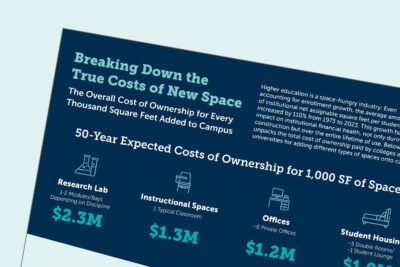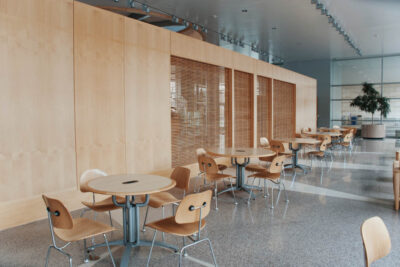How one college developed a permanent swing space solution for research labs
Swing space is notoriously elusive in higher education—especially for research labs. Most institutions lack unassigned lab space that can temporarily house new hires or researchers displaced by renovations due to high demand and operational costs. As a result, leaders must scramble to find lower quality, costly alternatives, like leasing off-campus space or renovating non-lab space on campus.
To provide researchers with quicker access to better short-term lab space—and maximize the value of their lab investments—institutions should consider designating fixed research swing space on campus. Read on to learn about the University of Vermont (UVM) College of Medicine’s dedicated swing lab.
How UVM’s swing space serves a wide range of short-term researcher needs
UVM’s College of Medicine seized the opportunity during a building-wide renovation to carve out a dedicated swing space for new faculty hires and current researchers needing more space for short-term projects. The swing space encompasses 2,000 square feet of wet and dry lab space. To accommodate diverse user needs, UVM equipped the space with standard features (e.g., fume hood, chemical storage cabinets, benches, write-up space) and used an open ceiling plan to enable the addition and removal of specialized equipment. Occupants also have access to additional resources—like a cold room, autoclave, and storage lockers—in the hallway outside the lab.

Interested researchers or departments can apply to use any portion of the space for one, three, or six months. The dean’s office makes allocation decisions, but consults the College’s space advisory group as needed. After approving an application, UVM gets the new user set up in under two weeks—a major improvement on the two months it previously took departments to troubleshoot short-term lab needs. While UVM does not charge researchers to use the space, occupants must cover any required activation costs, like equipment installation.
Three strategies for safeguarding swing space
Establishing a dedicated swing lab is an impressive feat, but the bigger challenge is maintaining control over it. Without a defense strategy, swing space will quickly get claimed by unsanctioned occupants. Institutions can use the following approaches to safeguard their research swing space:
-
Minimize the physical appeal
Most institutions try to avoid designing unappealing labs. But when it comes to swing space, generic design is a good thing since it reduces the likelihood that short-term users will seek permanent occupancy. To discourage long-term occupants, UVM has prohibited any customization to the swing lab. The dean’s office rejects all major renovation requests and requires occupants to keep the space in a standard configuration. Institutions could further reduce the physical appeal of their swing space by situating it in peripheral or less desirable campus buildings.
-
Restrict utilization and physical access
Institutions should establish a formal application process like UVM’s that requires central leadership approval. This prevents academic units from taking over the lab and ensures space is allocated in a standardized way that aligns with institutional strategic priorities. When reviewing applications, leaders should only approve requests after all other options (e.g., departmental space) have been exhausted. They also should restrict physical access to swing space by only issuing access cards or keys to authorized occupants. This prevents unapproved researchers and academic units from trying to claim the space for themselves.
-
Set clear parameters for temporary assignment
Institutions should assign swing space to researchers who have temporary needs and are unlikely to desire long-term occupancy. For example, researchers temporarily displaced during lab renovations probably won’t seek to stay in the swing lab indefinitely. Leaders should also set and enforce a maximum occupancy period like UVM’s, after which all occupants must vacate the space or reapply.
More Resources

Breaking down the true costs of new campus space

The Higher Education Leader’s Guide to Real Estate Optimization
